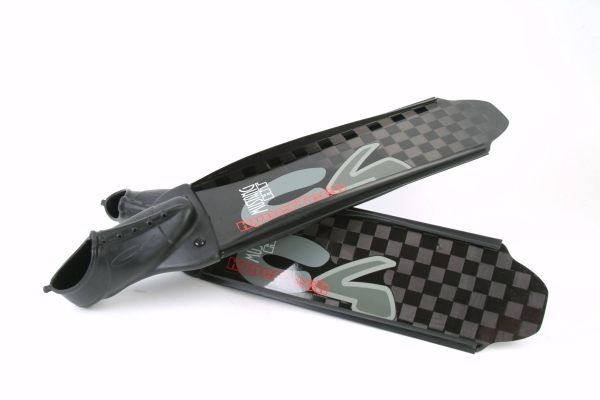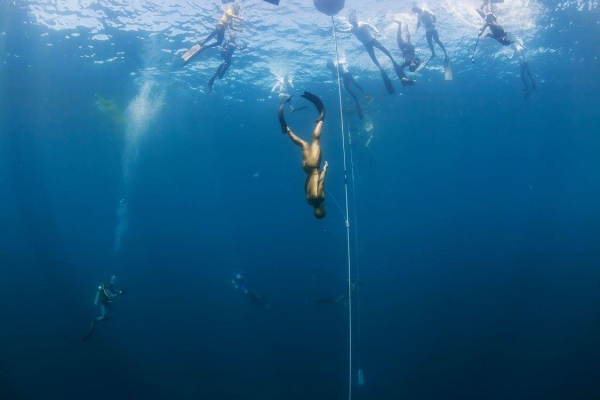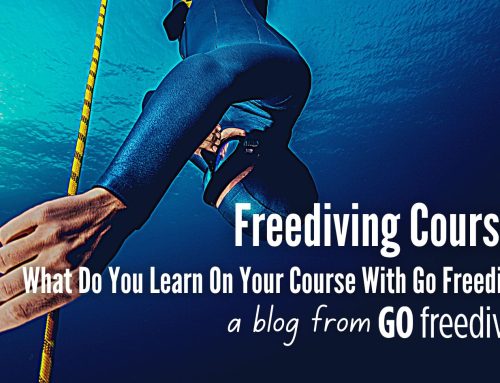Welcome to Part Fourteen of The Beginner’s Guide to Freediving, the best place to start your freediving journey. If you’re planning to start freediving, this chapter is about finning techniques for freediving – Why you should look at people walking before you start to fin, how a guide line can help with technique, and how to choose the right fins for you. This article will look at correct finning techniques for freediving, focusing on using bi-fins. We will look at the monofin in a later article.
Finning Techniques for Freediving – Comparing finning to walking
When starting to think about using fins, it’s helpful to get out of the water and look at how people walk. When we walk around, our legs are almost straight the whole time, and move an equal amount forward and back. We don’t move our legs as if we were pedaling a bicycle, only move them from inline with our body to behind us, or raise our knees up and down with the shins vertical and the toes pointed. Yet these are the most common mistakes people make when first learning how to fin.
Why does this happen? Apart from the unfamiliarity of being in the water learning a new skill, the biggest issue is, unsurprisingly, the fins. When freediving we wear long fins and these displace a lot of water. This makes using them difficult for some people as they learn to use their muscles in a different way.
Finning Techniques for Freediving – Common finning issues and correcting them from the start
When you first start to fin, it’s almost certain that the biggest mistake you will make is having a strong backward stroke (the part where your legs and fins go back behind your body) and a non-existent forward stroke (where your legs move from in line with the rest of your body to out in front). This is because it is easier to move the fins backwards and more challenging to bring them forwards.
This means that you will not descend vertically, but will instead dive into and/or past the dive line as the backward stroke will be pushing your body forwards.
To correct this, it is helpful to practice your finning upright on the surface. If you are upright with your head out of the water, try finning. If your legs end up behind you, tipping you forwards, your forward stroke is too weak. Once you start to improve your forward stroke, the tendency is to then to bend your legs at the knee, as this makes the stroke easier. Try not to fall into that habit – instead, keep your legs straight and concentrate on developing an equal forward stroke and backward stroke.
Finning Techniques for Freediving – Selecting the right fin for easy finning
At this point I want to break from technique to talk a little about fin strength, as this has a big impact on how easy it is to master the correct technique. Put simply, the greater the stiffness of the fin, the harder it will be to move through the water because it flexes less. Consequently, when selecting your fins, you should take into account what they will primarily be used for. If you are big and strong and going for depth then a stiffer fin may be appropriate. But if you are slighter and intending to do a lot of shallow recreational diving with lots of surface swimming, then you will need a softer fin.
It is much harder to perform correct finning techniques for freediving on the surface than it is under the water, so if you are doing a lot of shallow spearfishing in a current, where surface swimming plays a big part, then you will need a softer fin, or much of your energy will already have been used to hold your position on the surface before you’ve even had the chance to descend. I’ve even come across beginner freedivers whose fins are so stiff that when they need to swim a distance recreationally, it is more efficient for them to swim it under the water.
If you are using your fins in the pool then you also need to consider that you will not need to overcome positive or negative buoyancy, so choose a fin strength that makes it easy to fin a long distance and works well on the surface when buddying.
Finning Techniques for Freediving – Using a pool to learn finning technique
Practicing your finning techniques for freediving in the pool is a good way to identify and iron out any problems you might be having. It is useful to have access to a pool at least 25m long, with a consistent depth of 2m. A consistent depth enables you to fix your buoyancy and then concentrate on technique without having to adjust for a deep and a shallow end.
When finning, keep your head tucked in and in line with your body, and concentrate on a steady, even fin stroke with almost straight legs, and the fin moving an equal amount forward and back. Don’t worry about your fins hitting the bottom of the pool as this rarely happens. Your body needs to offer minimum drag through the water, so keep your upper body parallel to the bottom, regardless of whether your arms are by your sides or above your head. If you raise your head to look where you are going and/or arch your back you are increasing your drag through the water.
Finning Techniques for Freediving – Avoid being a banana in the water
Whether diving straight down for depth or horizontally in the pool, if you can see where you are going then your head is raised and your back is arched. I have drummed ‘tuck your head in’ so much to some students that they end up tucking their head in, but then arch their entire body so that they can see where they are going, turning them from a streamlined freediver into one resembling a banana.
If you are not interested in diving for depth, but want to use your freediving skills for recreational diving, photography or spearfishing then you might question the need to tuck your head in and streamline the body. My point is always this: If you use the correct finning techniques for freediving, then you will be able to stay under the water for longer. You will dive to exactly the depth you want and by descending vertically with minimal resistance, you will have more time at depth to look around and have fun.
Finning Techniques for Freediving – Letting the fin do the work for you and common problems
Another thing to consider when diving with bi fins is this: Get the fins to do the work for you. Once you have made a fin stroke, let the fin blade finish the movement before reengaging it. This will also help ensure you have a steady stroke rate.
You may experience your body rolling from side to side. There is often a slight roll naturally with your hips, but this should not be very noticeable. Just remember, you don’t walk with a big hip roll. Often connected to this is the scissoring out of the legs. Freedivers often say this is because they don’t want the fins to hit each other as they pass, however this will only ever be an issue if you are pigeon-toed as you fin, with your toes pointing inwards. Try and ensure that you fin with your hips level and your legs moving on an even plane backwards and forwards. To begin with you may need to select very soft or short fins until you master the technique and your ankles strengthen.
You will also need to check that both legs are working with equal strength, and that your fins fit snugly and comfortably. By minimizing any shift of the fins on your feet, you will maximize the transference of power through your legs, down through the blades and into the water. Use neoprene fin socks – they keep your feet warm, prevent chafing and can provide a nice, tight fit.
Choose comfortable fins that will enable you to easily master finning techniques for freediving without compromising power. Keep your upper body streamlined, your legs almost completely straight and move them equally backwards and forwards with a wide amplitude. Keep your hips level and your toes in line with your leg. Imagine you are walking, and let the blade finish a stroke before you start a new one.
Written by Emma Farrell
The Beginner’s Guide to Freediving is written by Emma Farrell. She is one of the world’s leading freediving instructors and has been teaching freediving since 2003. She is the author of the book ‘One Breath, a Reflection on Freediving’, has written courses that are taught worldwide, taught gold medal winning Olympic and Paralympic athletes, and has appeared numerous times on television teaching everyone from Hugh Fearnley-Whittingstall to Ellie Simmonds how to freedive.
Learn to freedive with the author of The Beginner’s Guide to Freediving
Go Freediving is the longest established, most experienced and friendliest freediving course provider in the UK, led by world class freediving instructor trainer Emma Farrell, and her team of personally trained instructors. No other course provider has such a good instructor to student ratio, safety record and personal touch.
Whether you’re a beginner dipping your toes into the world of freediving, a seasoned pro looking to turn professional, or simply a freediver of any level who wants the best freediving holiday in the world, we’re here for you!
Learn more about Freediving
Read the previous chapter of The Beginner’s Guide to Freediving – ‘How to do the Perfect Duck Dive for Freediving’ here now
Coming Soon: the next chapter of The Beginner’s Guide to Freediving – ‘Avoiding Black Outs and Hypoxic Fits in Freediving’
Keep in touch with everything Freediving
Subscribe to our mailing list for weekly newsletters with exclusive articles, news, films, offers and more!








Leave A Comment